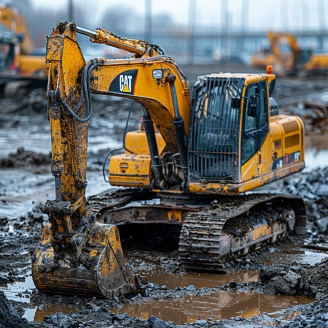以下に、土工事に関する指摘事項と英会話例を記載します。
1.土工事に関してよくある指摘事例
- Improper soil compaction (不適切な土壌圧縮)
- Incorrect excavation depth (不正確な掘削深度)
- Inadequate drainage provisions (不十分な排水対策)
- Slope instability issues (斜面の不安定性の問題)
- Non-compliance with soil erosion control measures (土壌侵食防止対策の不遵守)
2.土工事に関してよくある指摘事項とポイントを英語で説明する
まずは音声だけ聞いてみましょう。
Earthwork is a critical phase in construction that sets the foundation for the entire project. Here are key points to remember:
- Compaction: Achieve proper soil density as specified. Typically, 95% of maximum dry density for structural fill. Use appropriate equipment and techniques for different soil types.
- Excavation: Ensure correct depth and dimensions. Tolerance is usually ±50mm for general excavation, but may be stricter for foundations (±25mm).
- Drainage: Implement proper drainage systems. Slope grade should typically be at least 2% away from structures. Install drainage pipes as per design specifications.
- Slope stability: Maintain safe slope angles. For temporary excavations in cohesive soils, maximum slope is usually 1:1 (45°). For permanent slopes, it's often 1:2 (26.5°) or flatter.
- Erosion control: Implement measures like silt fences, erosion control blankets, or hydroseeding. Install before starting earthwork and maintain throughout the project.
- Soil testing: Conduct regular soil tests to verify properties. This includes grain size analysis, Atterberg limits, and in-situ density tests.
- Groundwater management: Monitor and control groundwater levels. Use dewatering techniques if necessary to maintain dry working conditions.
Always refer to geotechnical reports, project specifications, and local regulations, as requirements may vary based on site conditions and project type.
日本語訳:
土工事は、プロジェクト全体の基礎となる重要な段階です。覚えておくべき重要なポイントは以下の通りです:
- 圧縮:指定された適切な土壌密度を達成します。構造的な盛土の場合、通常は最大乾燥密度の95%です。土壌の種類に応じて適切な機器と技術を使用します。
- 掘削:正確な深さと寸法を確保します。一般的な掘削の許容誤差は通常±50mmですが、基礎の場合はより厳しく(±25mm)なることがあります。
- 排水:適切な排水システムを実施します。勾配は通常、構造物から離れる方向に少なくとも2%必要です。設計仕様に従って排水管を設置します。
- 斜面安定性:安全な斜面角度を維持します。粘着性土壌の一時的な掘削の場合、最大勾配は通常1:1(45°)です。永久斜面の場合、多くの場合1:2(26.5°)またはそれよりも緩やかです。
- 侵食制御:シルトフェンス、侵食防止マット、または種子吹き付けなどの対策を実施します。土工事開始前に設置し、プロジェクト全体を通じて維持します。
- 土壌試験:定期的に土壌試験を実施して特性を確認します。これには粒度分析、アッターベルク限界、原位置密度試験が含まれます。
- 地下水管理:地下水位をモニタリングし、制御します。必要に応じて排水技術を使用し、乾燥した作業条件を維持します。
常に地盤調査報告書、プロジェクト仕様書、および地域の規制を参照してください。要件は現場条件やプロジェクトの種類によって異なる場合があります。
3.土工事に関する英会話例
次は英会話例です。こちらもまずは音声を聞いてみましょう。
Project Manager: I've been reviewing the earthwork progress. There are a few concerns we need to address.
Site Engineer: I'm all ears. What specific issues have you identified?
Project Manager: First off, I'm worried about the compaction levels in the north-east corner of the site. The latest test results show we're only achieving 92% of maximum dry density.
Site Engineer: That's below our target of 95%. Do we know why we're falling short?
Project Manager: It could be due to inadequate equipment or improper technique. What type of compactor are you using in that area?
Site Engineer: We've been using a vibratory roller. Perhaps we need to increase the number of passes or adjust the vibration frequency?
Project Manager: That's a good start. Also, check the moisture content of the soil. It might need adjustment for optimal compaction.
Site Engineer: Understood. We'll retest the soil and adjust our methods accordingly. What other issues did you notice?
Project Manager: The excavation depth for the foundation seems to be inconsistent. Some areas are over-excavated by about 75mm.
Site Engineer: That's quite a bit off our ±25mm tolerance for foundation work. We'll need to backfill with lean concrete in those areas.
Project Manager: Agreed. Make sure to document this clearly. Now, about the drainage…
Site Engineer: Are you referring to the temporary drainage system we've set up?
Project Manager: Yes. I'm concerned it might not be adequate for the heavy rain forecasted next week. Have you checked the slope gradients?
Site Engineer: We aimed for a 2% slope away from the structures, but I'll double-check all areas. Should we consider adding more drainage channels?
Project Manager: That might be necessary. Also, ensure all silt fences are properly installed and maintained. We can't risk any erosion issues.
Site Engineer: Absolutely. We'll inspect all erosion control measures today and make any necessary repairs or additions.
Project Manager: Good. One last thing - have you been keeping an eye on the groundwater levels?
Site Engineer: Yes, we've been monitoring them daily. They've remained stable so far, but we have dewatering equipment on standby just in case.
Project Manager: Excellent. Keep up that vigilance. Remember, proper earthwork is crucial for the long-term stability and performance of the entire structure.
Site Engineer: Completely agree. We'll address these issues immediately and maintain stricter quality control moving forward.
Project Manager: That's what I like to hear. Keep me updated on your progress, and don't hesitate to raise any concerns as they come up.
日本語訳:
プロジェクトマネージャー: 土工事の進捗を確認していたんだが、対処すべき懸念事項がいくつかある。
現場技師: 聞く準備はできています。具体的にどのような問題を特定されましたか?
プロジェクトマネージャー: まず、敷地の北東角の圧縮レベルが心配だ。最新の試験結果では、最大乾燥密度の92%しか達成できていない。
現場技師: 目標の95%を下回っていますね。なぜ目標に達していないのか、原因は分かっていますか?
プロジェクトマネージャー: 不適切な機器や技術が原因かもしれない。その区域ではどのタイプの転圧機を使用しているんだ?
現場技師: 振動ローラーを使用しています。転圧回数を増やすか、振動周波数を調整する必要があるかもしれません。
プロジェクトマネージャー: それは良い出発点だ。また、土壌の含水比もチェックしてくれ。最適な圧縮のために調整が必要かもしれない。
現場技師: 了解しました。土壌を再試験し、それに応じて方法を調整します。他にどのような問題に気づきましたか?
プロジェクトマネージャー: 基礎の掘削深さにばらつきがあるようだ。一部の区域では約75mm過剰に掘削されている。
現場技師: 基礎工事の許容誤差±25mmからかなり外れていますね。それらの区域は貧配合コンクリートで埋め戻す必要があります。
プロジェクトマネージャー: そうだな。これを明確に文書化するようにしてくれ。さて、排水について…
現場技師: 設置した一時的な排水システムのことですか?
プロジェクトマネージャー: ああ。来週予報されている大雨に対して十分でない可能性を懸念している。勾配は確認したか?
現場技師: 構造物から離れる方向に2%の勾配を目指しましたが、全ての区域を再確認します。排水チャンネルを増やすことを検討すべきでしょうか?
プロジェクトマネージャー: それが必要かもしれない。また、全てのシルトフェンスが適切に設置され、維持されていることを確認してくれ。侵食の問題はリスクを負えない。
現場技師: もちろんです。今日中に全ての侵食防止対策を点検し、必要な修理や追加を行います。
プロジェクトマネージャー: 良い。最後にもう一つ - 地下水位は注視しているか?
現場技師: はい、毎日モニタリングしています。今のところ安定していますが、念のため排水設備を待機させています。
プロジェクトマネージャー: 素晴らしい。その警戒を続けてくれ。適切な土工事は、構造物全体の長期的な安定性と性能にとって極めて重要だということを忘れないでくれ。
現場技師: 完全に同意します。これらの問題にすぐに対処し、今後はより厳密な品質管理を維持します。
プロジェクトマネージャー: それを聞いて安心したよ。進捗状況を私に報告し続けてくれ。そして問題が発生したらためらわずに報告してくれ。






